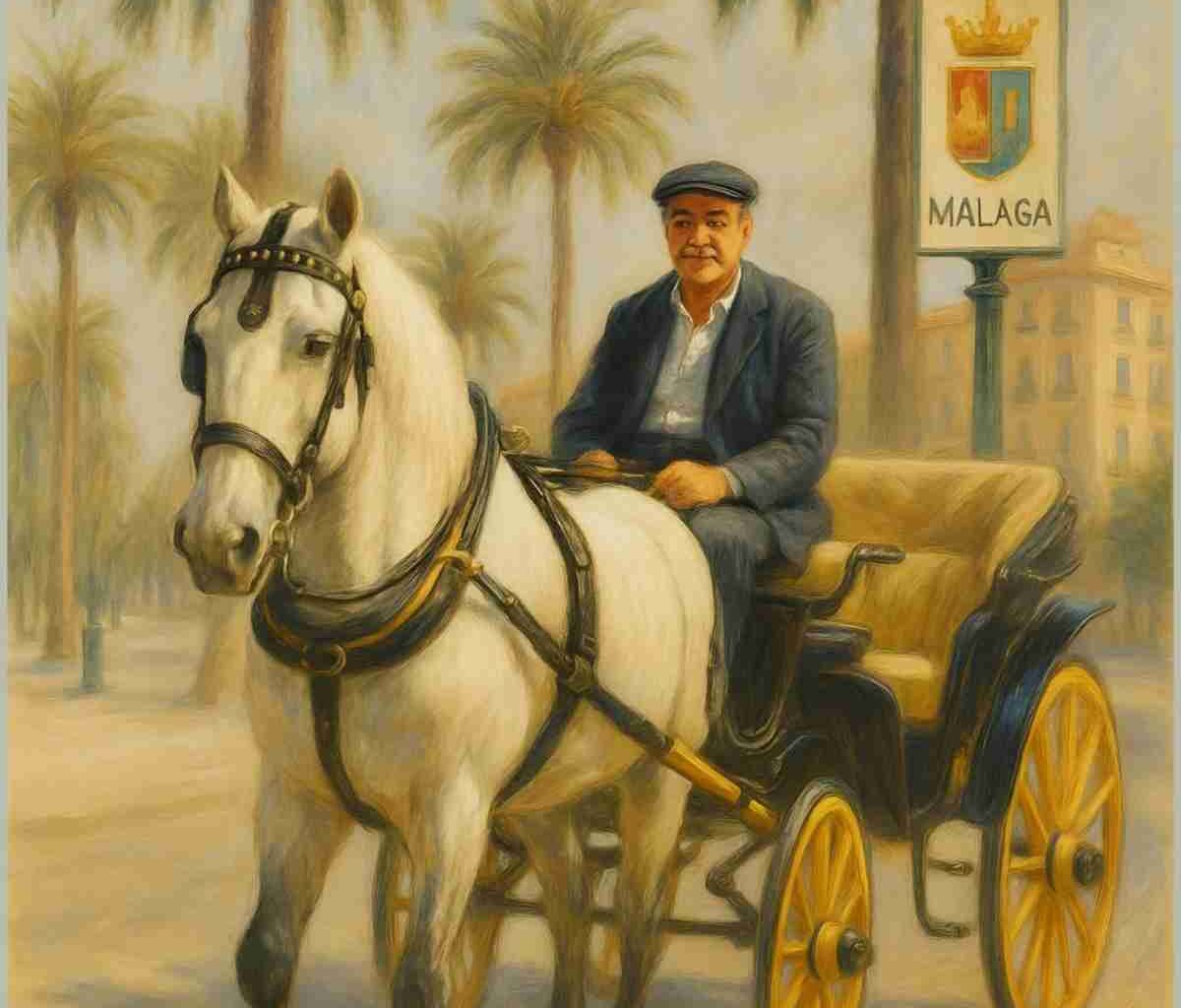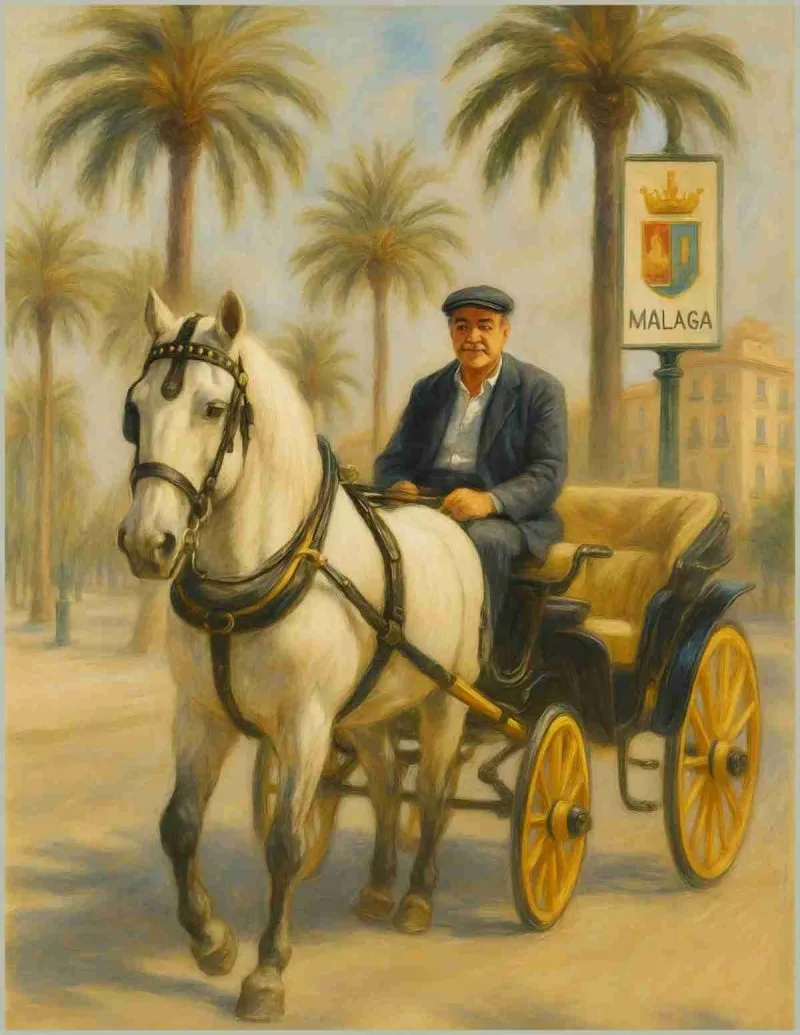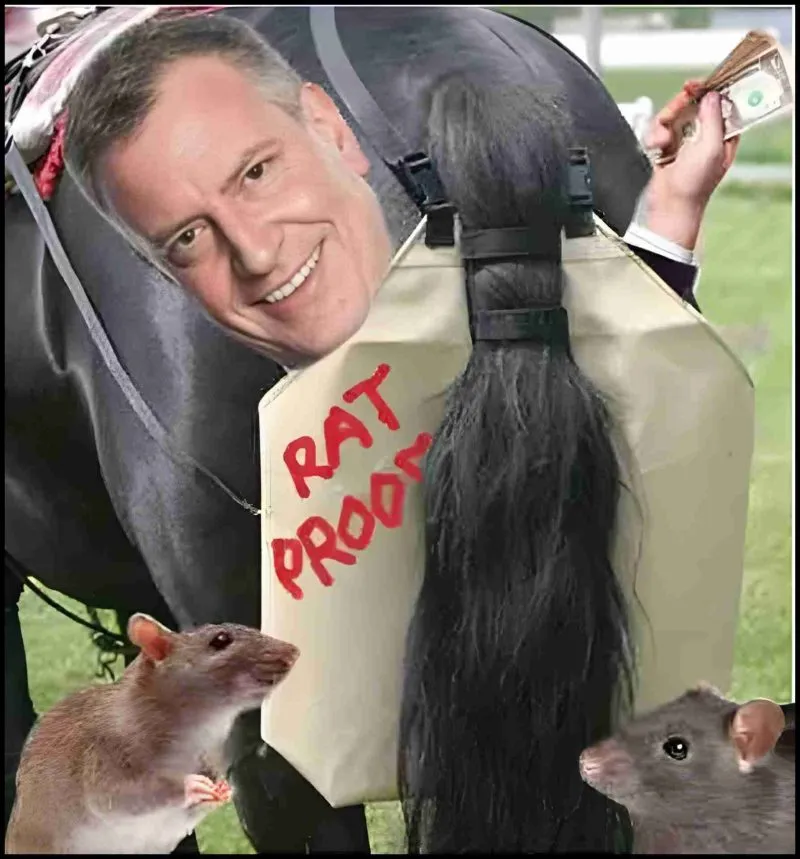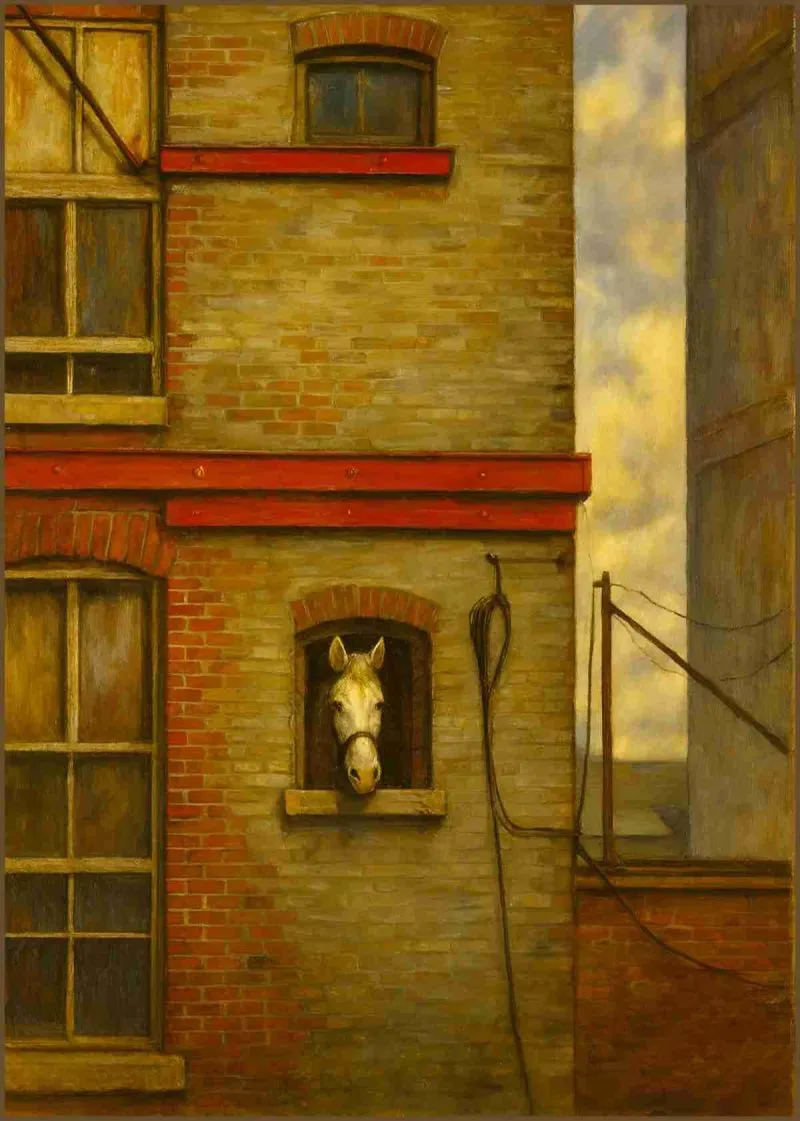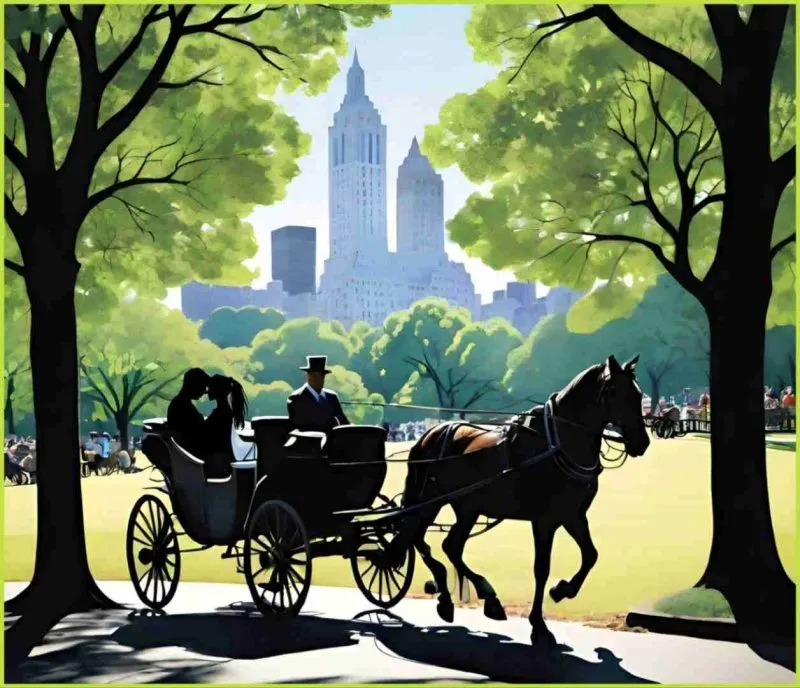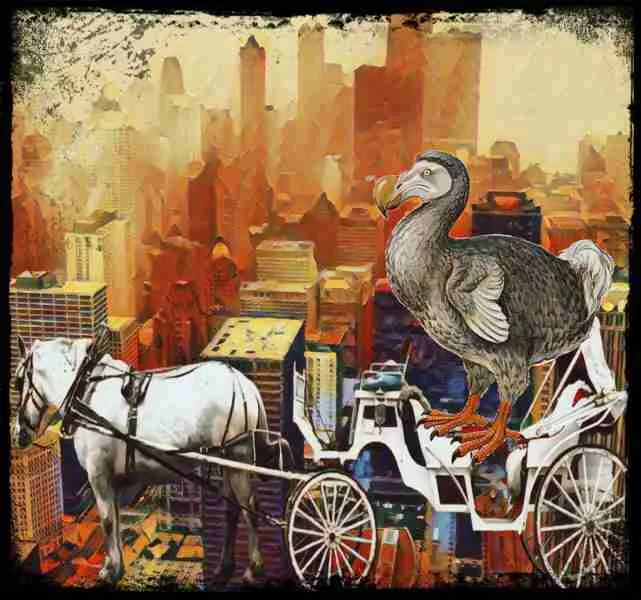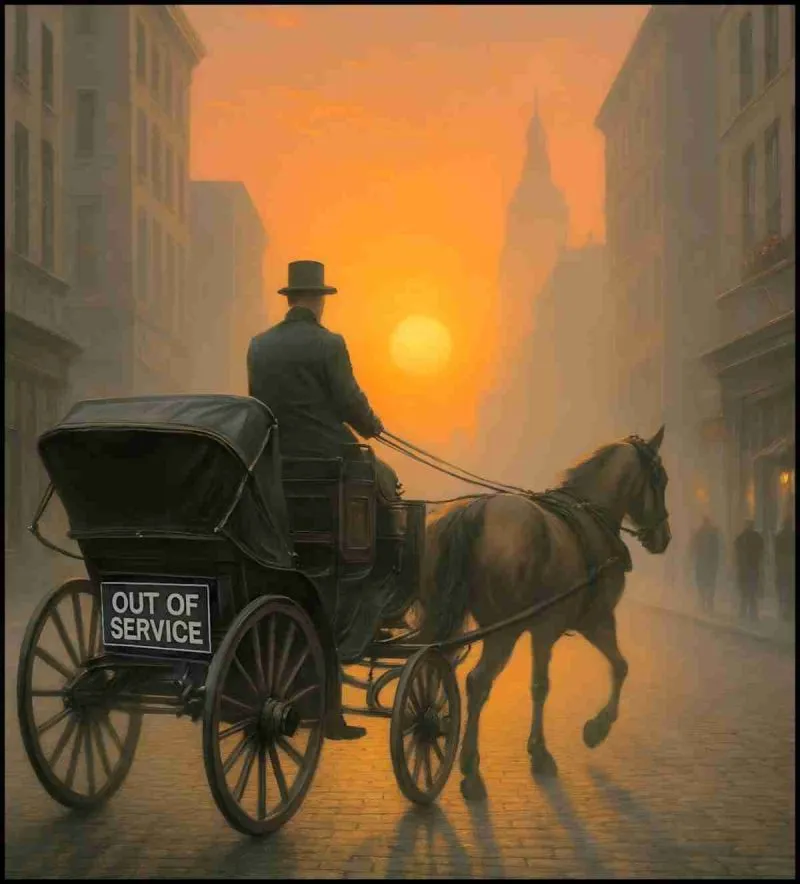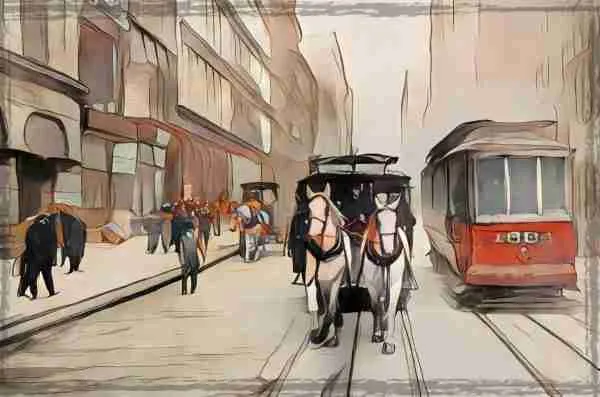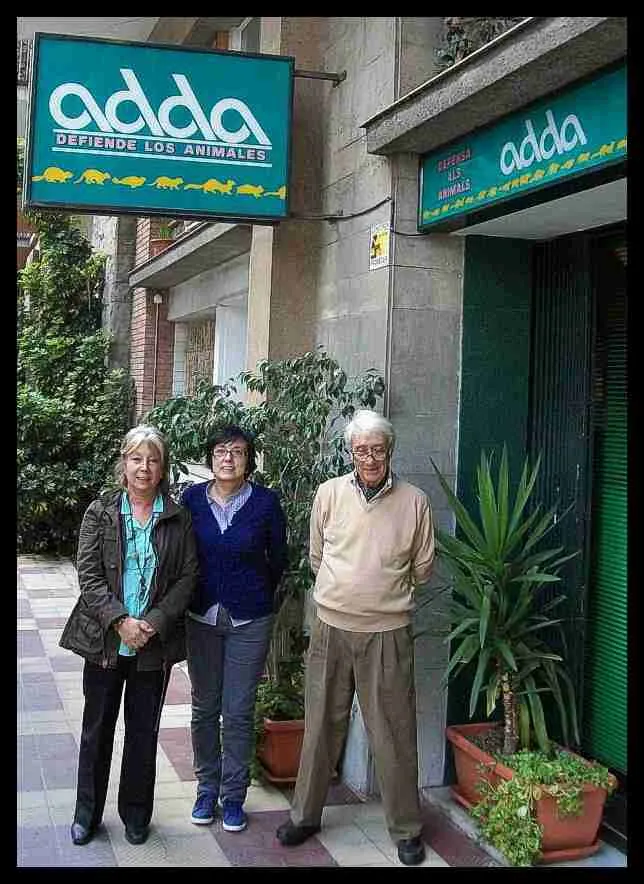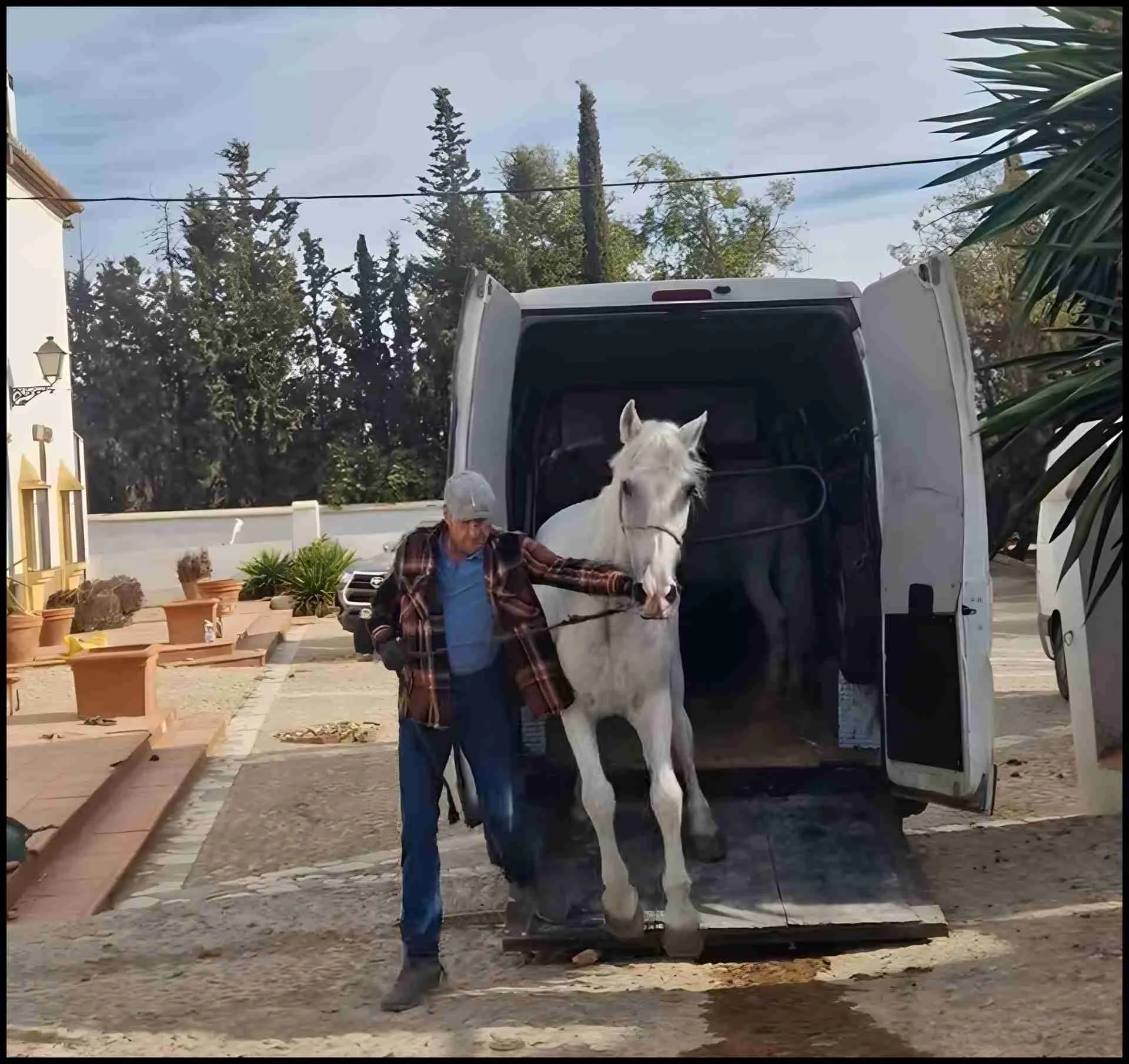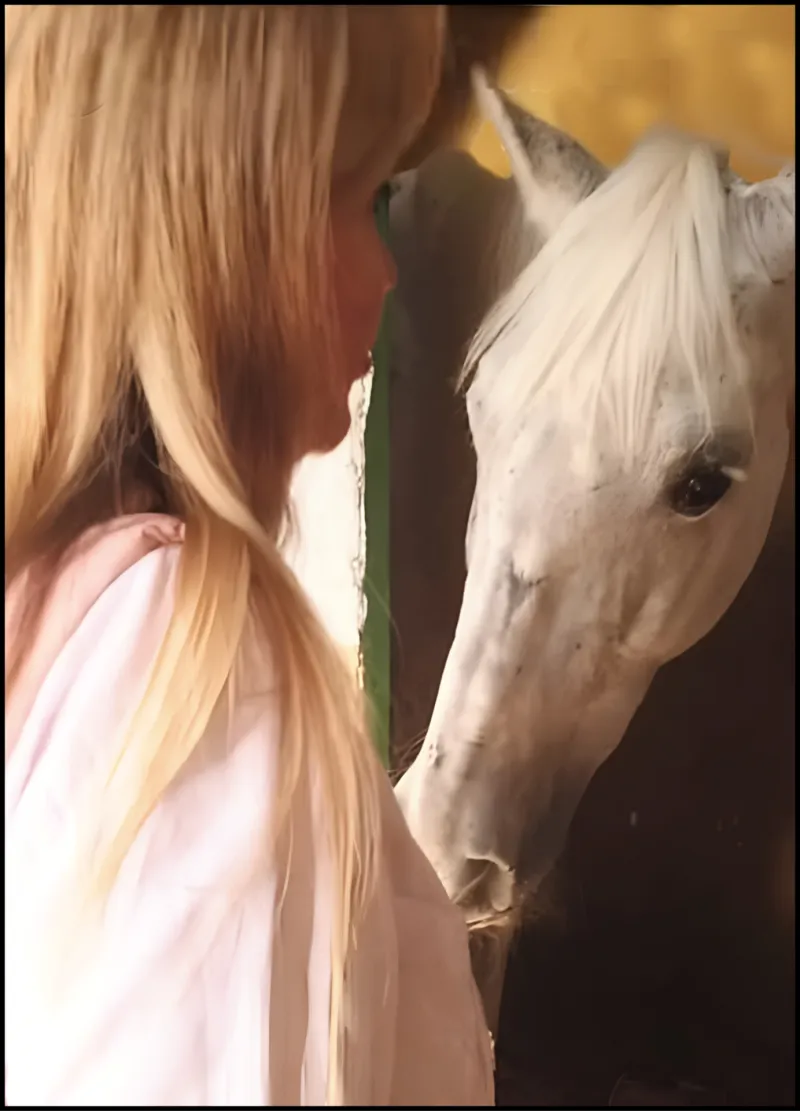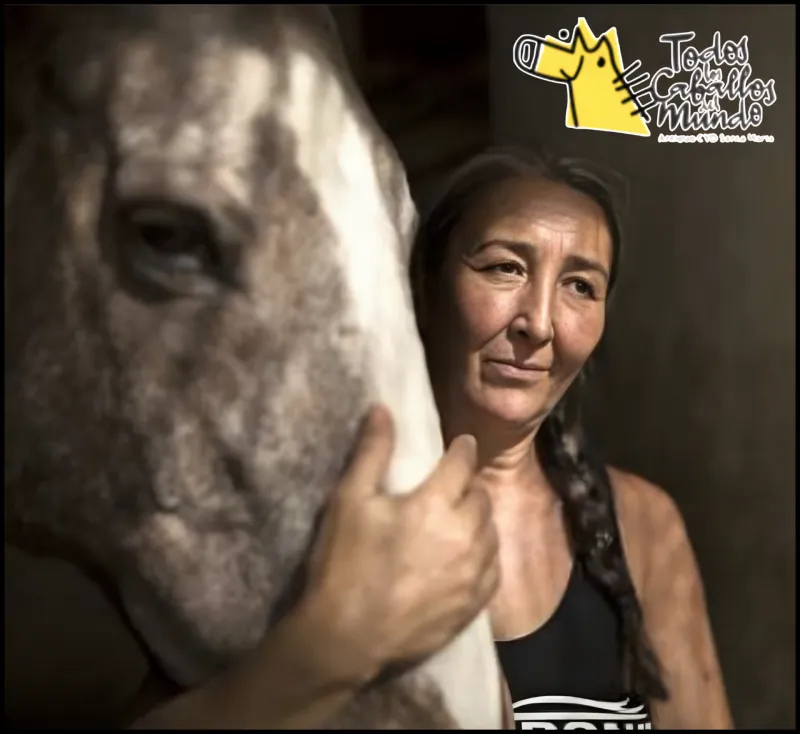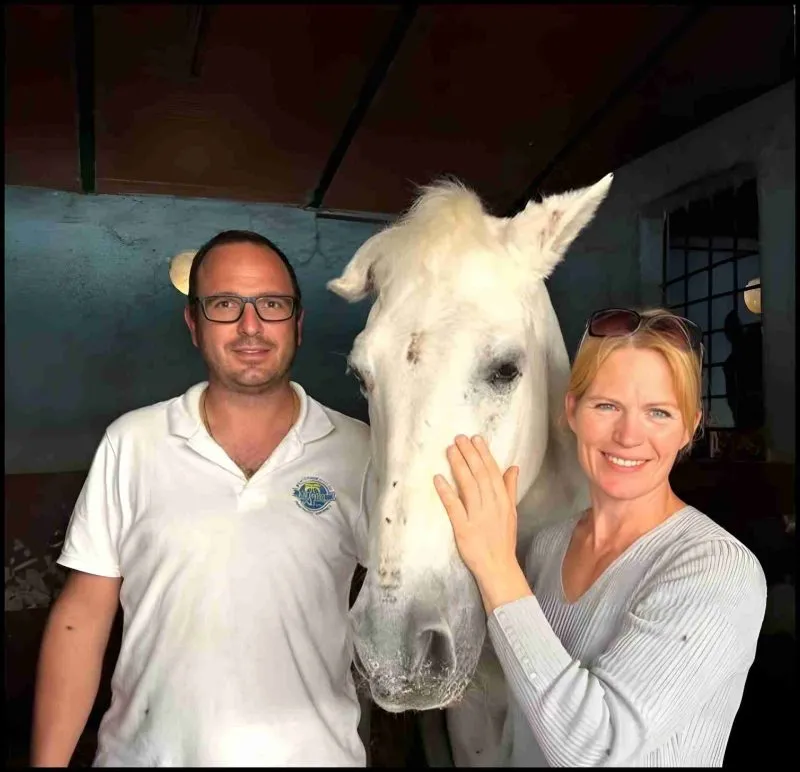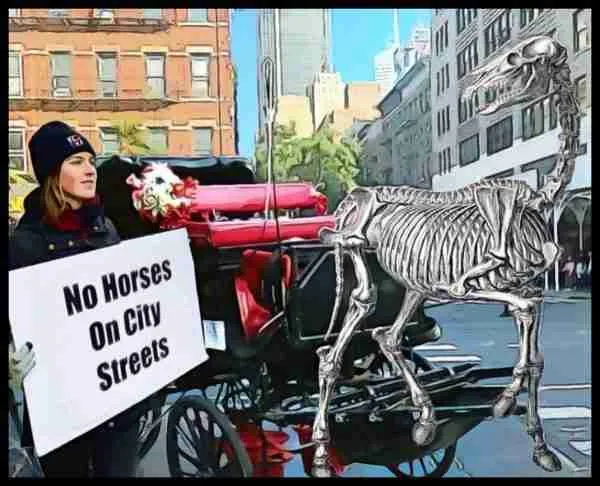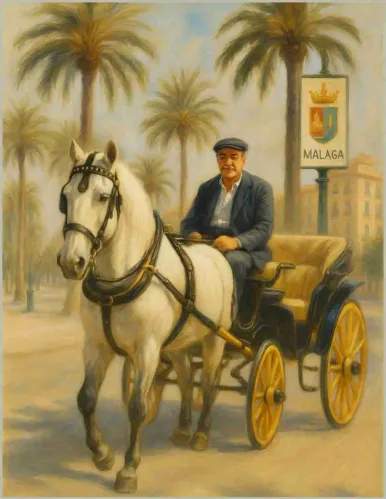
(Beth Clifton collage)All New York City mayoral candidates say they favor a ban, meaning none are accountable to horse advocates
NEW YORK CITY; MALAGA, Spain––The future of horse-drawn carriages in and around Central Park may not be the biggest issue on the minds of New York City voters in the November 4, 2025 mayoral election, a three-way fight among Zohran Mamdani and Andrew Cuomo, both Democrats, and Curtis Sliwa, a Republican, but it may be superficially the issue generating the most horse manure.
All three candidates have reportedly said they favor banning horse-drawn carriages. But so, supposedly, did retiring incumbent New York City mayor Eric Adams, who took office in 2022, did nothing to promote a horse-drawn carriage ban during most of his tenure, then announced his support for a ban just eleven days before abandoning his campaign for re-election on September 28, 2025.
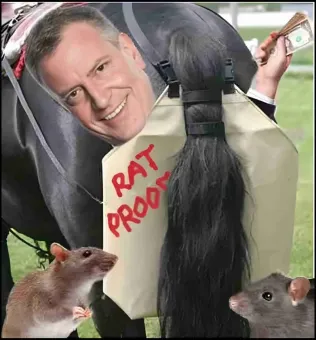
Bill De Blasio.
(Merritt Clifton collage)De Blasio, rats & the union
Previous New York City mayor Bill DeBlasio even won election in 2013 on a promise to ban horse-drawn carriages, bringing the endorsement of New Yorkers for Clean, Livable And Safe Streets, better known as NYCLASS, but once in office DeBlasio accomplished no more toward that goal than he did toward ridding New York City of rats, another of his ostensible campaign goals.
(See Nothing for carriage horses, $3 million for rat-proof garbage bags.)
A Zogby Analytics poll of 803 likely New York City mayoral election voters, commissioned by NYCLASS, found that 68% favor banning horse-drawn carriages, including 37% who strongly favor a ban.
But with all three remaining candidates purportedly on the same side of the horse-drawn carriage issue, the winner will not uniquely owe his election to his position on horse-drawn carriages, and in any event may not have the New York City council votes needed to buck Transport Workers Union support for the carriage industry.
Transport Workers Union members mostly work for the Metropolitan Transport Authority. Even a brief sympathy strike supporting carriage horse drivers could paralyze New York City.
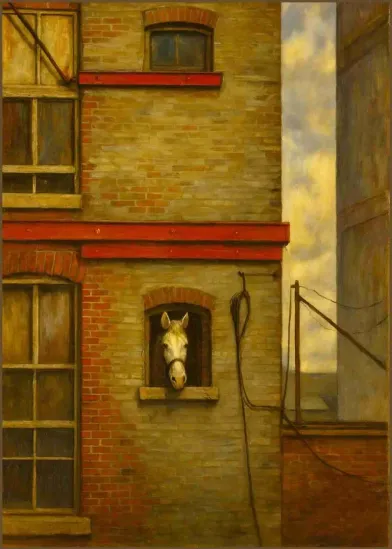
(Beth Clifton collage)“A mare’s mayor?”
Denouncing leading candidate Zohran Mamdani’s “flip-flopping on the ‘ban horse-drawn carriage issue,’” Coalition to Ban Horse-Drawn Carriages founder Elizabeth Forel on October 12, 2025 amplified “A mare’s mayor? Zohran Mamdani plays both sides in NYC’s carriage horse fight,” published three days earlier by Gothamist writers Elizabeth Kim and Liam Quigley.
“In one breath, “ Kim and Quigley observed, “Zohran Mamdani says he plans to ban carriage horses from Central Park. In another, he says he’ll form a panel to study the industry before coming to a decision.
“It’s the type of fence-straddling that’s become a feature of the mayoral front-runner’s campaign,” Kim and Quigley opined.
“Despite his lack of firm commitment on the issue, the two opposing sides of the long-standing fight each claim Mandami is in their corner.”
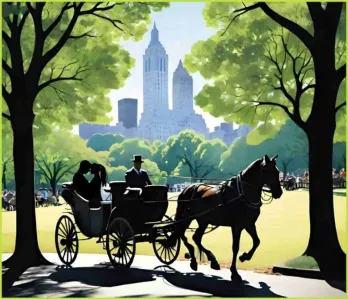
(Beth Clifton collage)Have stables, will visit
What Mamdani apparently promised most recently, according to Kim and Quigley, is “to visit the stables myself, and convene an independent panel of medical experts to assess the health of these horses.”
Responded Forel, “The stables do not provide turnout for the horses. Mamdani probably does not know what that means. Although conforming to the law, the stalls are too small at 60 square feet. He most likely does not know that horses require stalls of 144-196 square feet.
“I doubt he understands the nature of a horse ,” Forel wrote, “and that they are prey animals and will spook at the slightest provocation, becoming unwitting weapons with the potential of killing or injuring themselves, passersby, or destroying property.
“We recently saw an unmanned carriage, tearing through Central Park because the horse had been spooked. A passenger had to jump off. A committee only addressing the “health” of a horse is not going to reveal this.”
(See Why Paddy the horse probably wishes he didn’t go to work today and NYC mayor Eric Adams endorses bill to phase out horse-drawn carriages.)
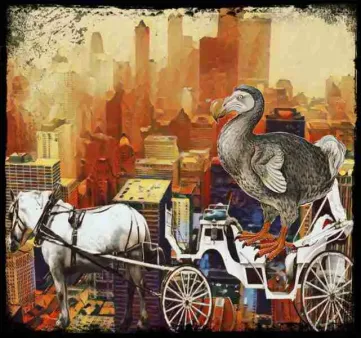
(Beth Clifton collage)Union threatens lawsuit
New York Daily News reporters Chris Sommerfeldt and Evan Simko-Bednarski meanwhile disclosed on October 7, 2025 that the Transport Workers Union “is making preparations to launch legal action against Mayor Adams’ top aide, Randy Mastro, and several other politically connected individuals over their efforts to ban the city’s horse carriage industry.”
The threatened lawsuit may go no farther than the last dozen years of campaign promises, but raises a potentially costly hurdle for Adams’ successor if he really tries to get horse-drawn carriages off the streets.
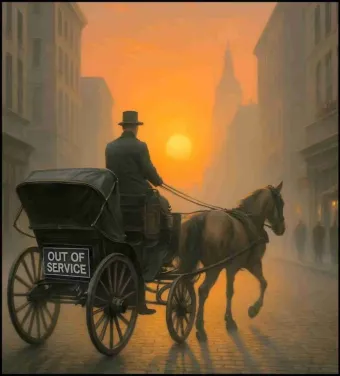
(Beth Clifton collage)Málaga expedites horse-drawn carriage ban
Málaga, Spain, meanwhile, population 595,000 in a metropolitan area of about a million people, an eighth the size of New York City but attracting 14.4 million tourists in 2024, almost a quarter as many as New York City, on October 6, 2025 made immediate a ban on horse-drawn carriages enacted earlier in the year that was originally not to take effect until 2035.
Revoking the 25 horse-drawn carriage licenses that were still in effect, the Málaga city council paid each carriage owner the equivalent of €125,380 in Spanish currency, or $145,520 in U.S. dollars.
Reported Luis Pavesio for Noticias Ambientales, an international online environmental newspaper published from Buenos Aires, Argentina, “For decades, horse-drawn carriages have been a common sight in Málaga, especially in its historic center. However, the negative impact on the animals did not go unnoticed.
“They were exhibited in poor health due to exhausting days in intense heat, poor housing conditions, and circulation in unsuitable urban environments.”
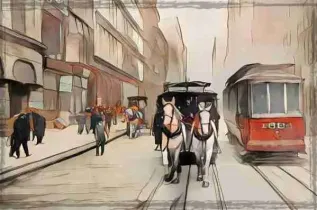
The last of the New York City horse-drawn buses, side by side with an electric tram in 1917. (Beth Clifton collage)Damages to the asphalt
Said Málaga council member Trinidad Hernández, “The horse-drawn carriage model is difficult to fit with the current animal protection regulations and the urban configuration of our city.”
Additionally, mentioned Pavesio, “it is estimated that damages to the asphalt caused by horseshoes amount to more than 50,000 euros annually. Something similar happens with horse-drawn carriages in Argentina.”
Offered Aïda Gascón, heading the Spanish organization Anima Naturalis, “This is a great advancement for animal protection in Spain. The disappearance of horse-drawn carriages in Málaga is an example of how change is possible when there is political will.”

Carmen Mendez, Montse Ong, and Manel Casas of the Barcelona-based Asociación Defensa Derechos Animal. outside their office in 2013.
(Merritt Clifton photo)Barcelona
Málaga, in Andalusia, is the second major city in Spain to ban horse-drawn carriages, following Barcelona, in Catalona.
Barcelona banned horse-drawn carriages in 2017, effective since June 2018 after a carriage horse died on a busy street. The Barcelona ban, however, allowed horse-drawn carriage use during days of traditional celebration including Els Tres Tombs and the Feast of Sant Medir.
The exemption brought the death of an eight-year-old horse during a carriage parade on the May 4, 2025 200th anniversary of the Els Tres Tombs festival––and brought immediate protest from Spanish animal rights organizations including Free The Animals, Girona Animal Save, the Partido Animalista Con el Medio Ambiente [PACMA], the Foundation for Advice & Action in Defense of Animals [FAADA], and Police for Animals.
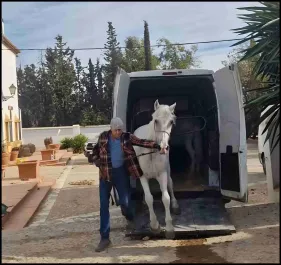
(Signe Fröslee Facebook photo)What will happen to the horses?
Noted Juan Soto of the Málaga online newspaper Sur in English, on October 7, 2025, “One of the big questions left to answer after the revocation of the 25 active horse-drawn carriage licenses in Málaga is what will happen to the animals. The city council has given the license holders one month to leave the stables in Teatinos, but the fate of the equines remains an unknown.
“If there are no changes to the current regulation,” Soto speculated, “the future of each horse depends on the owner’s decision. Many of the license holders have already started to look for buyers for both the animals and the carriages. However, the task will not be easy, because these animals are used to performing only the carriage service.”
Soto mentioned that some of the horses and carriages might “be moved to other places such as Marbella, Fuengirola, Mijas, Ronda, Seville, and Cordoba.
“The last option,” Soto said, “is for the animals to be slaughtered.”
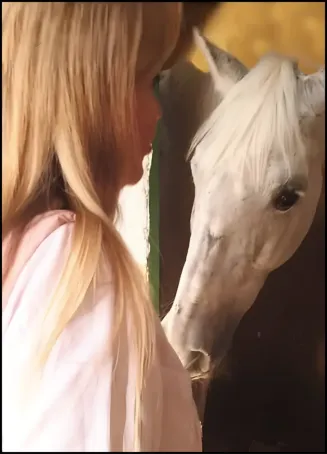
Anne Blitz. (Facebook photo)“Anne Blitz, from France”
Málaga mayor Francisco de la Torre suggested that the horses “could be integrated into some of the equestrian or riding centres in the city,” Soto reported.
Said De la Torre, “It is not the same as making the animal work long hours in the sun.”
On October 16, 2025, Soto updated that “Anne Blitz, from France,” has made the “‘hard decision’ to spend a large sum of money in order to save” some of the former Málaga carriage horses.
“Her association, Burrito y Caballo Libre,” Soto said, “has already secured two of the former carriage horses. One was purchased by her with the help of the group, and another by a friend.
“The pair are expected to arrive in the coming days at sanctuary A Better Life 4 Horses, owned by Signe Froslee, with Blitz covering the cost of their transport.”
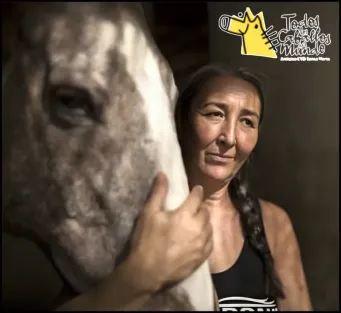
Concordia Márquez García. (Refugio Todos los Caballos del Mundo photo)Concordia Márquez García
Added Adrian Gamiz for Målaga Hoy on October 19, 2025, Blitz “had focused her work on the donkeys of Mijas,” but met Concordia Márquez García, director of the Refugio Todos los Caballos del Mundo, “who warned me that the coachmen were selling their animals before the stables closed at the end of October,” Blitz told Gamiz.
“Concordia was one of the main reasons why the carriages were removed in Málaga,” Blitz said. “She, along with PACMA, finally achieved it after years of work,” she acknowledges.
“Within a few days, Gamiz continued, “Anne, her association, and a close friend raised €2,900 [$3,373] out of their own pockets and purchased three horses directly from the coachmen.
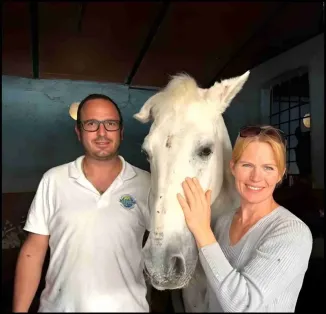
Jose Muriel Saldaña and Signe Fröslee with a rescued Malaga carriage horses who had been working since 2007. (Signe Fröslee Facebook photo)“They weren’t the only ones”
“But they weren’t the only ones,” Gamiz wrote. “Factor 3 Event and the A Better Life 4 Horses shelter in Antequera purchased six more horses, investing €8,700 [$10,118].
“In total, nine animals were rescued and transferred to the Antequera shelter, where they now live on fourteen hectares of land.”
Another “coordinated rescue effort led by Froslee and Concordia,” Soto said, “secured 12 horses.”
That left at least 40 of the 61 horses formerly used in the Malaga carriage horse trade unaccounted for.
The Easy Horse Care Rescue Centre, of Rojales, Spain, 285 miles northeast of Málaga, on October 22, 2025 lamented on Facebook that “all of the horses have been sold by their owners, and we do not know where they have gone.”
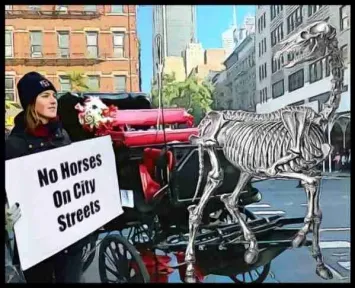
(Beth Clifton collage)Will Seville follow?
Commented Sevilla Secreta editor Ariana Buenafuente, “In light of the events in Malaga, the political party Podemos Sevilla asks the municipal government to establish a ‘public and transparent’ debate on horse-drawn carriages in Seville in order to know what the public thinks.”
Seville, a city of about 685,000 people in a metropolitan area of 1.5 million, attracts about three million tourists per year.
Travel writers, NewspaperArchive indicates, began mentioning horse-drawn carriage rides as an attraction in Seville in 1967.

Beth & Merritt Clifton.
(Daniel Leventhal photo)
The first mention of horse-drawn carriage rides as an attraction in Malaga, however, did not come until 1973, when Moberly, Missouri Monitor-Index publisher Donald W. Reynolds wrote that, “A horse-drawn carriage clip-clopped along the three-mile drive to the main fountain near the cathedral square. The charge was 25 cents and a 10-cent tip that sent the driver into ecstasies.”
Syndicated travel writer Kim Taylor in 1978 alleged that “The main mode of transportation [in Malaga], besides walking, is horse-drawn carriages. And every horse,” Taylor claimed, “has a small umbrella above its head, a law in Spain to protect the horses.”
Please donate to support our work:
More related posts:
Discover more from Animals 24-7
Subscribe to get the latest posts sent to your email.

